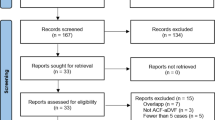Summary
A retrospective review of patients presenting to our institution with aneurysmal subarachnoid hemorrhage between 1980–1990 was accomplished. Eleven variables were examined as to their relationship to clinical vasospasm: age, sex, clinical grade, amount of subarachnoid blood on CT, aneurysm location, incidence of vasospasm, incidence of complications, use of calcium channel blockers, time to surgery, length of stay, and outcome. Data were analyzed with univariate and multivariate logistical regression methodology.
By univariate analysis, age under 20, amount of subarachnoid hemorrhage, and clinical grade were associated with a higher risk of vasospasm. Using multivariate logistic regression, these factors, along with age under 35, were correlated as being predictive of clinical vasospasm. When all patients are grouped into either good or bad outcome, and a similar analysis is performed, only in the poor outcome group is the amount of subarachnoid hemorrhage and clinical grade correlated with vasospasm. This suggests that there is a group of patients with a predisposition to vasospasm that is independent of subarachnoid hemorrhage and clinical grade, and that these patients may have a more favorable outcome.
Similar content being viewed by others
References
Black P (1986) Hydrocephalus and vasospasm after subarachnoid hemorrhage from ruptured intracranial aneurysms. Neurosurgery 18 (1): 12–15
Cervos-Navarro J, Gertz JH, Frydl V (1987) Cerebral blood vessel changes in old people. Mech Ageing Dev 39 (3): 23–31
Chyatte D, Sundt T (1984) Cerebral vasospasm after subarachnoid hemorrhage. Mayo Clin Proc 59: 498–505
Fisher CM, Kistler JP, Davis JM (1980) Relation of cerebral vasospasm to subarachnoid hemorrhage visualized by computerized tomographic scanning. Neurosurgery 6 (1): 1–8
Fisher CM, Roberson GH, Ojemann RG (1977) Cerebral vasospasm with ruptured saccular aneurysms — the clinical manifestations. Neurosurgery 1 (3): 245–248
Fleischer AS, Tindall GT (1980) Cerebral vasospasm following aneurysm rupture: a protocol for therapy and prophylaxis. J Neurosurg 52: 149–152
Giannotta SL, Kindt GW (1979) Total morbidity and mortality rates of patients with surgically treated intracranial aneurysms. Neurosurgery 4 (2): 125–128
Giannotta SL, McGillicuddy J, Kindt GW (1977) Diagnosis and treatment of postoperative cerebral vasospasm. Surg Neurol 8: 286–290
Graf CJ, Nibbelink DW (1974) A cooperative study of intracranial aneurysms and subarachnoid hemorrhage: report on a randomized treatment study: III intracranial surgery. Stroke 5: 559–601
Hajdu MA, Heistad DD, Siems JE, Baumbach GL (1990) Effects of aging on mechanics and composition of cerebral arterioles in rats. Circ Res 66 (6): 1747–1754
Hamel E, Assumel-Lurdin C, Bouloy M, MacKenzie ET (1990) Selective age-related changes in neuronal markers and smooth muscle reactivity in cerebrovascular beds of Fischer 344 rats. Neurobiol Aging 11 (6): 631–639
Hegedues K, Molnar P (1989) Age-related changes in reticulin fibers and other connective tissue elements in the intima of the major intracranial arteries. Clin Neuropathol 8 (2): 92–97
Heros RC, Zervas NT, Varsos V (1983) Cerebral vasospasm after subarachnoid hemorrhage: an update. Ann Neurol 14 (6): 599–608
Hunt WE, Hess RM (1968) Surgical risks as related to the time of intervention in the repair of intracranial aneurysms. J Neurosurg 28: 14–20
Hunt WE, Kassell N, Pertuiset B, Sano K, Teasdale G, de Villier JC, Drake CG (1988) Report of the World Federation of Neurological Surgeons Committee on a Universal Subarachnoid Hemorrhage Grading Scale. J Neurosurg 68: 985–986
Johnson MD, Wray A (1990) Alpha 1 adnergic receptor function in senescent Fischer 344 rat aorta. Life Sci 46 (5): 359–366
Kahn H, Sempos C (1989) Statistical methods in epidemiology. Oxford Press, London
Klassen AC, Sung JH, Stadlan EM (1986) Histological changes in cerebral arteries with increasing age. J Neuropathol Exp Neurol 27: 607–623
Kistler RM, Crowell KR, Davis R, Heros RC, Ojemann RG, Zervas NT, Fisher CM (1983) The relation of cerebral vasospasm to the extent and location of subarachnoid blood visualized by CT scan: a prospective study. Neurol 33 (4): 424–436
Kiwak K, Heros RC (1987) Cerebral vasospasm after subarachnoid hemorrhage. TINS 10: 89–93
Koike T, Ishii R, Ihara I, Kaneyama S, Takeuchi S, Kobayashi I (1981) Clinical analysis of cerebral vasospasm after subarachnoid hemorrhage-aging and cerebral vasospasm. No To Shingkei 33 (3): 499–504
Mizukami M, Kawase T, Usami T, Tazawa T (1982) Prevention of vasospasm by early operation with removal of subarachnoid blood. Neurosurgery 10: 301–307
Mizukami M, Takemae T, Tazawa T, Kawase T, Matsuzaki T (1980) Value of computerized tomography in the prediction of cerebral vasospasm after aneurysm rupture. Neurosurgery 7 (6): 583–586
Nagasawa S, Ohtsuki H, Yonekawa T, Handa H (1988) Clinical analysis of 60 aged patients with ruptured intracranial aneurysms. No To Shingkei Geka 16 (1): 17–21
Owen TL (1985) Reactivity of small vessels from mature to senescent female rabbits. Blood Vessels 22 (4): 172–178
SAS Institute, Inc (1988) SAS/STAT Users Guide, Release 6.03, SAS Institute, Inc Cary, North Carolina, USA
Suzuki M, Nobuyuki N, Hadeishi H, Sayuama I, Asakura K (1988) Cerebral vasospasm in aged patients with ruptured intracranial aneurysms. Neurol Med Chir (Tokyo) 28: 786–790
Topple A, Fifkova E, Cullen-Dockstader K (1990) Effect of age on blood vessels and neurovascular appositions in the rat dentate fascia. Neurobiol Aging 11 (4): 371–380
Vanhoutte PM (1988) Aging and vascular responsiveness. J Cardiovasc Pharmacol 12 (9): S 11–19
Author information
Authors and Affiliations
Rights and permissions
About this article
Cite this article
Rabb, C.H., Tang, G., Chin, L.S. et al. A statistical analysis of factors related to symptomatic cerebral vasospasm. Acta neurochir 127, 27–31 (1994). https://doi.org/10.1007/BF01808542
Issue Date:
DOI: https://doi.org/10.1007/BF01808542




